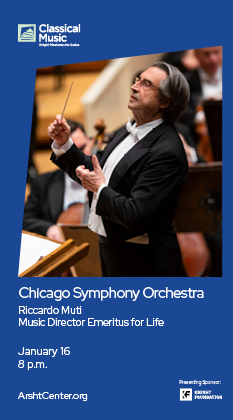Corigliano premiere opens Festival Miami with brassy power
By age 25, most young people are moving out of the house, striking out on their own, and starting new futures. So too has Festival Miami, which opened its 25th season Thursday evening with a salute to composer John Corigliano at the Knight Concert Hall of the Adrienne Arsht Performing Arts Center.
While this is not the first time the festival has ventured off the University of Miami campus—in 2002 it presented the ballet, Cecelia Valdes at Miami-Dade County Auditorium—it is clearly a new day for Festival Miami under Shelly Berg. The dean has revamped the lineup to form thematic weeks of different genres, opening the five-day classical “Great Performances” series with this tribute to Corigliano, one of our finest composers. It’s too bad that with such a worthy event and the composer in attendance, the turnout was so disappointing with the house less than 25 percent of capacity. Holding the concert on Yom Kippur clearly didn’t help.
Of the three Corigliano works performed by Frost School of Music forces, the most significant was the Florida premiere of his Circus Maximus. Inspired by using the spatial resources of a large modern concert hall, Corigliano’s uninhibited third symphony is set in eight connected movements and calls for large wind ensemble, including marching band, saxophone quartet and eleven trumpets spread out across the balconies.
As its name implies, Circus Maximus draws a sharp parallel between the massive entertainment spectacles of ancient Rome and contemporary America with our own plugged in, downloaded, iPhone-equipped lives. The composer implies that, instead of focusing on the world’s survival, our preoccupation with electronic bread and circuses may lead to the same end as that of the Roman Empire.
Circus Maximus is an extraordinary work, the moments of theatricality like the marching band and shotgun blast at the coda used not as gimmicks but to reflect the excesses and real dangers of frenetic modern society.
It’s safe to say that the Knight Concert Hall hasn’t had a test drive like this since the Chicago Symphony performed Richard Strauss two season ago. The spatial effects worked magnificently, from the antiphonal trumpet fanfares of the opening Introitus to the sultry insinuating seductions of Screen/Siren, with the saxophone quartet and double-bass placed in the second-tier balcony.
The symphony has its deafening moments and cacophony but also passages of great beauty as with the Prayer movement, a fragile searching solace that rises to a rich lyrical outpouring. Corigliano’s inventive use of instruments is on full display in Night Music I with evocative nocturnal sounds and uncannily lifelike lupine wails. Only the Channel Surfing third movement didn’t quite come off Thursday, the contrasts too ironed out and the mercurial remote-control clicking unclearly presented.
Otherwise Gary Green led a powerful, well prepared performance with the gifted musicians of the Frost Wind Ensemble excelling in their varied and challenging assignments. It’s too bad a female audience member had to shout a premature “Bravo!” which unleashed the applause and spoiled the stark coda and silence after pianist Liana Purcell fired the climactic shotgun blast high up in the choral seating.
Corigliano’s Red Violin Concerto has seen more manifestations than the title instrument of the 1998 movie has had owners: from film score to Caprices and concertante Suite, Chaconne, and now a full-fledged four-movement concerto.
The Red Violin Concerto adds three movements to the existing Chaconne, mining the movie’s varied themes. While the concerto is full of Corigliano’s frenetic drive, percussive rhythmic bite and creative instrumental writing, particularly in the final movement, the expression is largely lyrical, wistful and rhapsodic, offering myriad technical challenges and expressive opportunities for the violin soloist.
Corigliano could not have wanted for a more compelling performance that that served up by soloist Jennifer Koh, who made a very impressive local debut. The violinist tackled the score’s complexities with a crackling intensity that gave terrific bite to the driving passages while her even, tight vibrato added tartness to the openly lyrical pages.
The Frost Symphony Orchestra lacks the sonority and gleam of a professional ensemble though the student musicians performed solidly and with conviction, some wayward intonation apart. More problematic was the conducting of Yongyan Hu. The Chinese maestro’s stolid direction and poky tempos consistently undermined Koh and sacrificed forward momentum. It would have made more sense to have the Frost School’s Thom Sleeper on the podium, since he’s worked closely with the orchestra for the past month and has a proven record of getting excellent results from student forces.
The evening led off with Corigliano’s choral setting of Baudelaire’s L’invitation au voyage. Corigiano’s skill at word-setting, aided by Richard Wilbur’s precise yet sensual English translation— is striking, almost conversational in its attentive word painting. A cappella choral events have not been plentiful in the Knight Concert Hall,which is unfortunate, for the sound of the Frost Chorale’s massed voices was stunning, radiant with glowing tone.
In his local debut, Joshua Habermann, the Frost School’s new director of choral studies, showed himself a very fine conductor indeed. Habermann sensitively balanced choral sections and elicited a wide array of coloring and dynamic details with feather-soft pianissimos, which bodes well for his UM post and imminent leadership of the Master Chorale of South Florida.
Posted in concert review
Leave a Comment
Fri Oct 10, 2008
at 5:16 pm
No Comments






